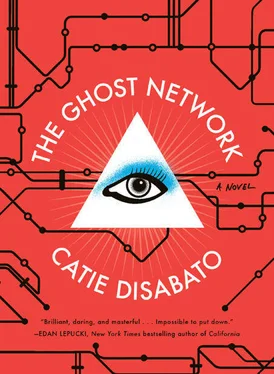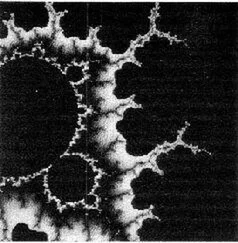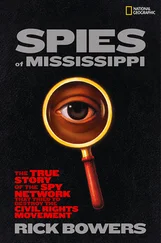“Peaches seemed very tall,” Berliner told me, when I asked about his first impressions of the dancers. He was bored by the question.
When I asked the dancers about Berliner, Peaches said, “What a pretentious asshole.”
After I spoke to Ali and Peaches about meeting Berliner, rI realized both dancers half-blamed Berliner for Molly’s secrecy, like a cuckolded wife blaming the woman her husband slept with, rather than the true source of her dissatisfaction: the husband.
In the hotel room, they all sat on the bed, drinking from minibar bottles, while Molly and Berliner explained what they’d been up to. Molly had never hinted at her secret work with Berliner, so Ali and Peaches were surprised when Molly told them about the energy she’d already put into researching Guy Debord and the New Situationists, as well as the amount of time she’d put into the Urban Planning Committee. They never knew Molly to scheme behind their backs; she constantly updated them, overwhelming them with detail on the objects and outfits she designed for her music videos and stage shows. In introducing the dancers to Berliner, Molly revealed a secret second life, and changed Ali and Peaches’s perception of her forever. That night, Molly Metropolis became a person that could keep an important secret behind someone’s back, a person not to be entirely trusted.
Berliner did his best to quickly explain the Situationists, the New Situationists, and his theory of the L maps to Ali and Peaches, while Molly fixed everyone drinks and hummed the Britney Spears song “(You Drive Me) Crazy.” When Berliner finished talking, Molly asked Ali and Peaches if they wanted to join the Urban Planning Committee. She said, “Everything we’re doing here is top secret and vitally important not only to ourselves but the entire world.” (Molly often referred to the project as “vitally important to the entire world,” the same way she called herself a pop star before her first record came out.) A little nonplussed, but generally inclined to follow Molly’s directions, Ali and Peaches agreed to help.
“We just have to get maps?” Ali asked.
“You will never just do anything,” Molly replied.
However, gathering maps did become their central focus for the next few months. To gather every map of every iteration and every proposed iteration of the Chicago L system took time, energy, dedication, and organizational focus. Luckily, the materials were readily available, for the most part. The Chicago Transit Authority (CTA) posted L maps from the last twenty years on their website. The Chicago Historical Society archived every L map the CTA ever published, and the Chicago Public Archives housed all of the City Council’s meeting minutes and recordings, including discussions of all proposed L expansions or reformations. The Chicago Public Library acted as a catchall, to fill in any gaps, as did Berliner’s sometimes-girlfriend, Johnson, who was both a librarian and an amateur Chicago historian. Johnson, a leggy but plain architecture student, told them the Chicago Housing Council had designed their own reconfigurations of the L system and presented them directly to the Chicago Transit Authority, not the City Council. The records of those plans were only available through the Chicago Housing Council, which doesn’t make their records public.
Peaches solved the problem by seducing Andrew Pierson, the male assistant to the head of the Chicago Housing Council. Pierson had a sexual fetish for women dressed as schoolgirls (utterly boring, but remarkably common), and Peaches took to the character with relish. She returned from her trysts with her hair in messy pigtails, photocopies of the Housing Council’s proposals from the early 1960s to the mid 1990s stuffed in her bag, and jump drives full of digital files of proposals from the ’90s to the present.
Although she liked to play, the slow and boring work of acquiring the L maps weighed on Peaches. She wasn’t studious like Berliner and Molly, preferring to live in her body rather than her mind. When she hung out with Molly, she wanted to go clubbing or cuddle or work on improving Molly’s dancing skills; she didn’t want to talk about maps or think about secrets. When we spoke, Peaches still sounded resentful: “Once we knew about the maps thingy it was like she stopped having to try with us. She wasn’t trying to be nice anymore. Some days she’d be her old self, fun and effusive, like she was. Then other days she’d be moody and snap at me just for asking a simple question. The worst part was, she wasn’t like that with Nick, no matter what. Even when he was being an idiot. She was always so goddamn sweet to him.” For a while, Peaches ignored her growing resentment and directed her considerable worth ethic to the task Molly had assigned her. While Ali and Peaches focused on acquisition, Berliner examined and organized the copies of the maps they brought to him. He created a catalogue on his computer, categorizing the maps by year, city location, and type (accepted proposals, accepted proposals that were never built due to various interruptions, unaccepted proposals, and even some plans that had been drawn but never formally proposed). When Ali and Peaches left Chicago to dance for Molly, Berliner took over acquisition duties as well, often spending fifty or sixty hours a week building his detailed archives and filing maps.
The work of a librarian suited Berliner well, as did the work of a print maker, which he also took on at that time. Molly asked him to make brightly colored screen prints of various L maps to decorate her New York and Los Angeles apartments. Berliner also purchased, with funds from Molly, several original Edge of the World maps from his old map shop and made some screen prints to hang alongside the originals on the walls of the underground hideout in the Racine building, both to decorate and claim the space formerly belonging to the New Situationists as Urban Planning territory. Molly judged Berliner’s screen prints by her typical stringent standards of aesthetic quality.
Their double responsibilities as dancers and researchers wore Ali and Peaches a little thin, but Molly Metropolis never tired out. She spent all of her free time, when she wasn’t writing music or designing and shopping for her outfits, compiling the maps using a custom mapmaking computer program she commissioned called MollyMaps. She hired a computer programmer to write her the mapmaking program, where she could organize various maps based on Berliner’s categories of year, location, and type. The programmer thought he was making her a platform to track her touring schedule.
When Molly visited Chicago, she copied the maps into MollyMaps on a computer that she never connected to the Internet. Eventually, when the number of maps became too overwhelming for her to digitize on her own, Molly gave Berliner a copy of MollyMaps and bought him his own laptop. When Berliner met up with Molly on tour or when she visited him in Chicago, they synched their maps over a closed wireless connection.
As 2007 slid into 2008, Molly’s relationship with Peaches fell apart. The rift developed slowly. At first, they just snapped at each more often, poking at each other with pithy, bitchy remarks when they were both tired or overwhelmed with work. For a while, they would apologize after their little snipes. Then they stopped apologizing. When Ali was there to act as a buffer, Molly and Peaches got along fine, so to avoid arguing, Molly and Peaches stopped spending time by themselves. Very quickly, they forgot how to have fun together; alone in a room, they argued or lapsed into uncomfortable silence. Molly stopped discussing her personal life with Peaches and never asked advice about her family or romantic entanglements. They still spent almost every day together, but without meaning to, they stopped being friends.
Читать дальше












